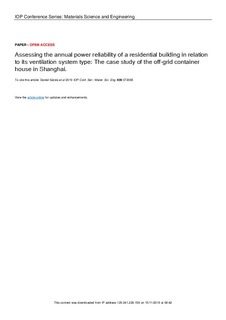| dc.contributor.author | Satola, Daniel | |
| dc.contributor.author | Kristiansen, Audun Bull | |
| dc.contributor.author | Dziedzic, Jakub Wladyslaw | |
| dc.contributor.author | Gustavsen, Arild | |
| dc.date.accessioned | 2019-11-18T10:55:10Z | |
| dc.date.available | 2019-11-18T10:55:10Z | |
| dc.date.created | 2019-10-24T12:20:23Z | |
| dc.date.issued | 2019 | |
| dc.identifier.citation | IOP Conference Series: Materials Science and Engineering. 2019, 609 . | nb_NO |
| dc.identifier.issn | 1757-8981 | |
| dc.identifier.uri | http://hdl.handle.net/11250/2628972 | |
| dc.description.abstract | In developing countries, electrification of rural and remote areas is an essential need for improving socio-economic conditions. However, increased access to adequate electricity and upgraded facilities may double or even triple present greenhouse gas emissions related to residential buildings operation. From both socio-economic and environmental perspective, implementation of solar-powered houses is widely considered as a sustainable. Power reliability is a key indicator used in assessing the annual performance of the off-grid housing operation. The primary objective of this article is to ascertain the impact of three main ventilation system types: natural (NV), mechanical with heat recovery (MV) and hybrid (HV) on annual power reliability of the case, off-grid building located in Shanghai. Firstly, three scenarios of hourly electricity loads profiles were calculated from an annual simulation via building performance software (BPS). Secondly, electrical load profiles were integrated into a developed model of alternating current (AC) coupled battery off-grid energy system model. The results indicate that the HV system provided the lowest annual electricity consumption (2847 kWh) and the best annual power reliability (98.6%) when compared to MV (2935kWh, 98.5%) and NV (2901kWh, 98.0%). The article discusses correlation between building ventilation scenarios, electrical loads and resultant annual power reliability. In conclusion economic viability of mechanical/hybrid ventilation implementation in off-grid housing is called into question. | nb_NO |
| dc.language.iso | eng | nb_NO |
| dc.publisher | IOP Publishing | nb_NO |
| dc.rights | Navngivelse 4.0 Internasjonal | * |
| dc.rights.uri | http://creativecommons.org/licenses/by/4.0/deed.no | * |
| dc.title | Assessing the annual power reliability of a residential building in relation to its ventilation system type: The case study of the off-grid container house in Shanghai. | nb_NO |
| dc.type | Journal article | nb_NO |
| dc.type | Peer reviewed | nb_NO |
| dc.description.version | publishedVersion | nb_NO |
| dc.source.pagenumber | 8 | nb_NO |
| dc.source.volume | 609 | nb_NO |
| dc.source.journal | IOP Conference Series: Materials Science and Engineering | nb_NO |
| dc.identifier.doi | 10.1088/1757-899x/609/7/072065 | |
| dc.identifier.cristin | 1740184 | |
| dc.relation.project | Norges forskningsråd: 257660 | nb_NO |
| dc.description.localcode | Content from this work may be used under the terms of theCreative Commons Attribution 3.0 licence. Any further distribution of this work must maintain attribution to the author(s) and the title of the work, journal citation and DOI. Published under licence by IOP Publishing Ltd | nb_NO |
| cristin.unitcode | 194,61,55,0 | |
| cristin.unitcode | 194,64,25,0 | |
| cristin.unitname | Institutt for arkitektur og teknologi | |
| cristin.unitname | Institutt for energi- og prosessteknikk | |
| cristin.ispublished | true | |
| cristin.fulltext | original | |
| cristin.qualitycode | 1 | |

